One habit I’ve gotten into over the years is making sure the night before I take a look at tomorrow’s calendar and send an email confirming every meeting I have. I confirm the time, place, and give my cell number.
I felt compelled to write about this because very few of the people I meet with do this. It seems so important and not often done at all. I wonder about this a lot.
Why is this important?
1. In many instances, the other person didn’t write down or put in their calendar that we were meeting. Now I’m wasting my time going somewhere expecting a meeting and they aren’t!
2. The other person couldn’t make it, but I wouldn’t have found out if I didn’t email them! They either didn’t bother to tell me or it kept slipping their mind to tell me but my email reminded them to bring up that fact! Many times if they have assistants, good ones will reconfirm and tell me if their boss can’t make it; but often I have to email the assistants to find out!
3. I want to make sure that the other person has my cell number handy, and in a recently accessible place: within 24 hours of email, in case something goes wrong at the last minute. Then they can call or text me to tell if they are late or can’t make it. I have found that contact management for a lot of people is very, very spotty.
4. I or the other person has often made the mistake of thinking we were meeting somewhere else! So confirming helps reinforce the place we’re going to meet.
As mentioned before, in the confirmation email I put the time, place, and my cell number. If I can, I will find the original email which sparked the meeting and put in the confirmation. Or I will write a short sentence reminding them of why we are meeting if it’s not obvious. I like to make sure I remind the other person why we’re meeting or else it may be awkward for both of us wondering why we’re meeting in the first place.
Before I meet someone for the first time, I try to pull up some info about them: LinkedIn, Google, an executive summary, pitch deck, look at their website, remind myself of who introduced us. This is to help break the ice and get the conversation going. Sometimes I’ll be doing this on my iPhone while walking to the meeting; other times, I’ll print out the materials and flip through them before the meeting. Or I’ll get to our meeting place early and do it all there. Familiarizing yourself before the meeting shows you care enough to have spent time to do that. I think it speaks a lot for showing respect for the other party.
Many times I’ll also try to find their picture online which helps immensely to find the other person in a crowded venue. Likewise, I may email or text to the other person what I’m wearing and what I look like so they can find me easily.
If I’m somewhat late to the meeting, I try to text/email/call them that I’m going to be X minutes late. This is also showing common courtesy that you’re running late and that they aren’t just sitting there waiting for you, wondering if you’re going to show up at all. But generally, I try to get to someplace early; tardiness is not a good habit to get into!
All this seems like basic good meeting habits but, as I’ve observed, it happens very seldom. I would love to see more people learn these habits, and certainly I assign a new level of respect to anyone who sends a confirmation email before I do!
Monthly Archives: October 2010
Talk About the Problem, Not Just the Solution
When I meet with entrepreneurs, the conversation often goes like this:
We start by talking about the startup idea or problem they are trying to solve. We spend about a minute on that and then we dive into a product demo. He starts showing me the product, all the cool widgets, flash effects and interactivity and then I raise my hand and call a (hopefully polite) halt. I pull him back to the problem definition and often have to drag him back to talking about it because he often wants to go back to showing me how cool the website or product he built is.
Here is the problem with this. I have not bought into the problem statement yet, but the entrepreneur assumes I have. And it very much seems like he wants to sell me on the beauty of the execution alone, which I may agree looks really elegant and well done. However, creating a startup is not just about building the product, it’s about why we’re doing it in the first place. If I don’t agree with that yet, then it doesn’t matter how we execute or what we’re building.
To me, building the product is the most straightforward (out of a potentially chaotic customer discovery process) part of a startup; building the right problem statement is much more important and difficult. After all, how do you know that you’re building the product to solve the right problem?
By right problem, I mean all those things that are so important to contributing to the success of the startup: big enough market, do users have a big enough want or need, can you monetize, are there competitiors or none, etc. etc. If, in that first few minutes of problem definition, I don’t believe your problem statement is worth building for, then it’s pointless to keep showing me how great your product is executed.
After I call a halt to the product demo and I explain why, often the entrepreneur looks at me incredulously and tells me you’re the first investor to want to stop looking at the product. This is frightening to me; are there a crew of investors out there who care more about how cool the product is than why they are building the product in the first place?
My favorite pitches tend to follow a form which I learned in high school about writing compositions.
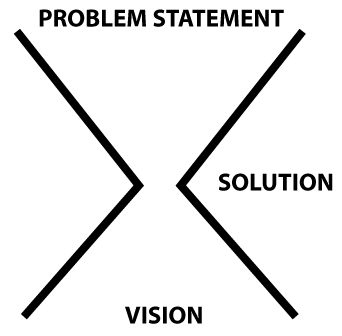
With the introductory paragraph, you start broad and then work down to your problem statement which generally is the last sentence in the introduction. Then the next 3 or 4 paragraphs offer proof of your problem statement. The last paragraph is the concluding paragraph, which summarizes the key points in defense of your problem statement and usually tries to end with a broader concept.
In a pitch, this starts with a lot of time talking about the problem statement, why we’re doing this and why it’s a great idea to be working on this venture. Once we establish this, we can talk about what they’ve accomplished from a product standpoint. After we go through that, we go back to the company and widen the discussion to what they’re going to do in the future, and talking about where this company can go from here (and hopefully see the opportunity to grow huge).
These entrepreneurs’ pitches look more like this:
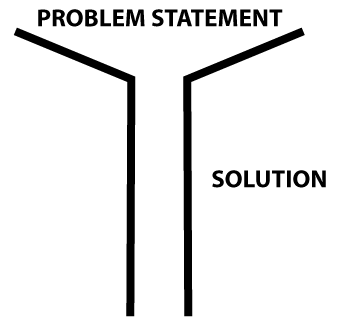
We start broad for about a minute and then we narrow quickly into a deep dive into the product itself. At the end of the discussion, assuming I haven’t stopped them first, they just ask me how much money I want to contribute and that’s that.
No discussion about the future, no talk about company vision, no assurance that there is a real big opportunity here; just a cool product and someone who wants money to develop it further.
Here’s are the issues:
1. Talking about vision and potential future of the company is important. It gives you a defining vehicle in which to drive the company forward. It provides direction internally, and external understanding about what your company is all about. If you don’t have this, you could be really stuck at some point if your current product isn’t getting traction and you won’t have some sort of map to follow; you’ll be forced to define one on the fly and you might not be able to.
2. If you never talk about the vision, I will never know if you will ever get one. I have found some people don’t ever get the vision. They can’t ever get their heads out of what they’re doing at that moment. They somehow are missing the strategic gene, and only have the tactical – so they are great sergeants but not generals. But it’s the generals that will build the Googles, not sergeants who can’t advance beyond their rank. That doesn’t mean that sergeants aren’t important; it’s just a problem if they are trying to build a startup which requires someone to think like a general to know if they are working on the right problem.
3. If we never talk about the vision, then I won’t know if you’re aiming for the right opportunity. If all I see is an incremental improvement on what’s out there, or something small like a feature (how ever nifty it is), it’s just not going to get me excited because I need to bet on the next big thing not just another little thing.
4. Here’s another way to look at it. The world contains a whole bunch of problems that you could work on, and a whole bunch of solutions:
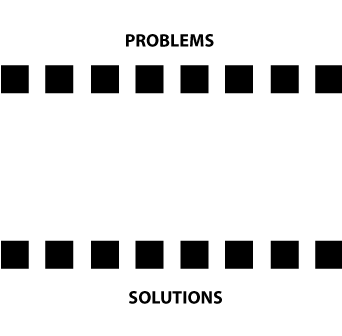
So you lightly define a problem, and then you start building and coding because that’s what you’re good at and you want to get cranking. So you crank.
Now, starting with this solution, you’re aiming for some problem:
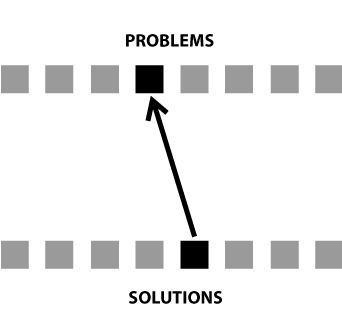
But your problem definition isn’t complete. It’s nebulous. The problem with this is, if you had a great problem definition, you might actually be spending time on the wrong solution. If you started with a great problem definition, you might actually end up with a better solution than the one you worked on now:
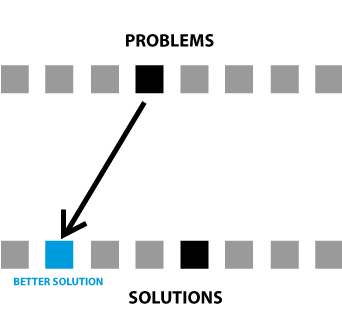
This is because the set of possible solutions can be enormous and unless you define the problem well, you might be wasting time building something which may not be the optimal solution from the right problem! So why not show me that you understand and have defined the problem fully, and then show me that you’re working towards an optimal solution to this problem, versus me feeling unsure that you’re working for the optimal solution to some problem which I’m not sure yet whether you should be working on!
So are we headed for a small business, or the next Google? Talking about your product in detail is nice and important, but I want to hear about why you’re building it in the first place as much as how much you want to demo what you’ve built.
Taking Your Pro Rata as Angel Investing Strategy
In thinking about my angel investing strategy going forward, I started thinking about how venture funds always talk about taking their pro rata allocations in their winning companies, or even raising their share of the companies. They do this to keep “leaning on the winners” meaning that the will increase their investment “bet” on these companies which are doing well (and stop investing in those that aren’t doing so well). This then increases the return they get, while also minimizing the risk somewhat.
I thought that this may be a good angel investing strategy as well. In the world of the so-called lean startup and capital efficiency, everyone talks about finding a startup that only requires one round of financing, then gets to breakeven and profitability without requiring more rounds of financing. They get big and then an exit happens making everyone happy with the return because there is no dilution.
However, in practice, this is very hard to find. The twists and turns a startup can take invariably means that more money needs to be spent before they get to breakeven/profitability. Also, in today’s competitive world, getting huge quickly can give you a leg up on the competition and doing so may mean that you need some more funding to build your team quicker and to scale the business faster; without that funding, your organic earnings can’t give you that velocity of growth. The probability of needing another round or more than one extra round is definitely higher than the probability of getting lucky and dropping into a business that needs only one financing round.
As more financing rounds happen, then previous shareholders get diluted as someone new wants a piece of the company. We can either let ourselves be diluted, or, if we invest further, we can maintain at least our percentage ownership. Then when an exit happens, we maximize the return we get instead of watching our percentage ownership dwindle and get screwed for us helping the startup so early.
Here I started thinking that this may be a good way to invest even as an angel investor.
If you invest only in the first round as an angel investing strategy, then you must try for the lowest pre-valuation and hope for capital efficiency so that an exit can happen without further rounds of funding. But waiting for the perfect funding opportunity may mean you will pass on or miss some of the best opportunities even if the pre-valuation is not the best. Or the probability of a startup being truly capital efficient enough to get to be huge, or just to a decent exit, without further rounds of funding is very low.
Also, you must put in a large amount of money in the beginning, thus commiting capital at the most riskiest moment of a startup’s life: the beginning.
Then I started thinking that perhaps assuming I would not invest only in the first round, but also in subsequent rounds, then I could gain some advantages.
If I assume that dilution will happen, or assume that further rounds of financing will be required which is probably a more likely case, then I could commit lesser funds in the beginning, take my pro rata on each subsequent round, and still maintain my percentage ownership into the future. At some point in the future, I would have been diluted to this percentage ownership in any case. I would be, in effect, dollar cost averaging into the investment. Over a period of time, I could place relatively small bets into the winners of my portfolio, with each amount being within the range of my single investment amount.
I could also invest capital only when risk was reduced, meaning that if a company were successful and growing and could raise another round to grow further, then I would commit more capital rather than committing it all at the first round, when the chance for losing it all was greatest.
Now the problems with this are…
Getting my pro rata investment ability can be really tough in later rounds. A lot of venture terms exclude small investors in later rounds from being able to take their pro rata. If I don’t have specific pro rata rights, I would have to fight for my ability to invest further by having a great relationship with the founders and/or CEO. I may not be able to take my pro rata and maintain my percentage ownership.
At some point, the amount I would have to invest in a given round will inevitably grow to be beyond my ability to invest. My hope would then be maintain percentage ownership as long as possible before I couldn’t invest any more because that amount exceeded my ability to invest out there at any one time. So I might still get diluted if further investment rounds happen.
A lot of early investment rounds are in notes with caps, and those notes have no terms defined yet. It is quite possible that if I invest in an opportunity like that, that I will have no pro rata rights at all when the round finally converts into an equity round. Thus, I take a lot of risk when I invest in those companies with respect to employing this strategy.
When I talk to VCs, they always tell me that “leaning on the winners” meaning investing in futher rounds, taking their pro rata or even increasing their percentage ownership in the companies of their portfolio which are doing great, results in the greatest returns. So shouldn’t I do the same, even as an angel investor?
I would love to hear from more experienced angel investors and see if they have ever tried to employ this strategy in investing.
Warm Gun: Alternative Impressions
I just got back from a whole day of hanging out at the Warm Gun: Designing Happiness Conference put on by Dave McClure and his crew at 500startups. Once again, it was a stellar event, gathering designers and developers and the occasional investor (like me, although I guess I’m also a designer and developer with my CS degree). I thought I would post about the event, but post differently than posting just the notes or what was good and not so good. Instead, I thought I’d post some alternative impressions that I got while at the event which I thought were interesting.
I was shopping for a lot of books!
Two presenters gave some suggestions for reading, Geoffrey Miller and Jennifer Aaker. Through them I instantly bought on Amazon:
We Feel Fine: An Almanac of Human Emotion by Sep Kamvar and Jonathan Harris
resonate: Present Visual Stories that Transform Audiences by Nancy Duarte
The Mating Mind: How Sexual Choice Shaped the Evolution of Human Nature by Geoffrey Miller
Spent: Sex, Evolution, and Consumer Behavior by Geoffrey Miller
I am glad that some of the presenters did give favorite texts because it is hard to take notes in a conference setting; they talk fairly rapidly and move through slides so quick that it is hard to take the important points down. Some of them thankfully will either post their presentations on Slideshare or email them to me personally which is pretty cool.
Ex-Yahoo! designers, the next generation
I met a few designers who had been doing design at Yahoo! and left relatively recently. Most of them got there after I had left, with one I saw who was there when I was there and was still had not left!
But seeing them present and hearing about the work they did for some reason gave me a lump in my throat. I spent 9 years at Yahoo! as VP of User Experience and Design and we did so much while I was there. Now there was the new generation who designed for Yahoo in not only a new regime but new internet environment of high bandwidth, HTML4 going on 5, advanced browser technologies, faster computers, iPhone and iPads – it was a much different environment than the one I had designed Yahoo! sites for way back when. For some reason I felt nostalgic for the old days, but was impressed by their skills and knowledge and also felt disconnected with the new generation.
It was good to say hi and talk about the Yahoo!s that we respectively knew and where we were going from there.
“Twitter intros” were everywhere
What an amazing thing Twitter does – I walk into Warm Gun and immediately I am meeting and talking to people as if they know me because they tell me they have been following me on Twitter for a while now – I do the same to them if I recognize their names by their Twitter handles.
It certainly breaks the ice and for many, we seem to already know each other before meeting in person!
On the other hand, it is vaguely stalker like – should I be afraid…?
“Those who do not remember history are destined to repeat it.”
Sitting through the last presentation of the developer track, I was listening to Tom Chi, former Yahoo! search designer and now at Google. He was giving a quick talk on the intricacies of designing a search user experience.
A lot of the things he talked about were things we did when I was still at Yahoo (although afterwards, we got into a great discussion on all the cool things they were doing that weren’t mentioned in the presentation due to time constraints). Still, I could not recall where anyone had recorded information about search UX much. One of my designers, Christina Wodtke (now at MySpace) wrote about search UX design in her book, Information Architecture: Blueprints for the Web (2nd Edition). On Boxes and Arrows, there are a few stories about search UX:
Advancing Advanced Search
Search Behavior Patterns
Long Tails and Short Queries (which references an excellent research article by Amanda Spink, From E-Sex to E-Commerce)
But if you didn’t know where to look, it would be potentially really hard to find this information. And the new generation of designers might not even try to find it before trying to design a search experience on their sites. What a shame that would be: they would most likely make the same mistakes that others have made before them. IF ONLY they had the knowledge of others before them!
Yet I find that much of the deep knowledge tends to be proprietary or trapped in the minds of individuals who worked on the problems and then went elsewhere, or left to rot on departing employees’ hard drives.
At Yahoo! we had a website where we made all the user researchers upload their usability reports into one place so that we could always go back and see what others had done before them. Now that I’ve been gone for 6 years, who knows if that repository still exists. Certainly the individuals have been scattered to the four winds.
Perhaps this is something that someone on the internet would do, which is to create a repository of design knowledge. Perhaps we could somehow get donations of historical proprietary data. Perhaps we could save presentations from all the talks both formal and informal (like on Slideshare). Maybe it could be a Design Wikipedia, or something like Television Tropes & Idioms where every formula for a TV show has been recorded and basically reused and recombined for new shows.
Otherwise, we’re going to be relegated to finding these individuals and making give the same presentation over and over again for each new generation of designers…maybe that’s yet another great reason to hold Warm Gun next year!